A Neuro-Evolution Heuristic Using Active-Set Techniques to Solve a Novel Nonlinear Singular Prediction Differential Model
Abstract
1. Introduction
2. Construction of Second Order NLE-PDSM
- A novel second kind of NLE-PDSM was derived through the LE fundamental system and numerical evaluated by the proposed ANN-GAASM.
- Comparison of results using the designed model, obtained via the proposed ANN-GAASM with exact solutions, was authenticated in order to check the stability and correctness by solving three different problems using the proposed NLE-PDSM.
- For convergence and accuracy measurements, statistical tests based on semi interquartile range (SI-R), Nash–Sutcliffe efficiency (NSE) and Theil’s inequality coefficient (TIC) were performed to solve the second kind of NLE-PDSM.
- Alongside the reasonably precise outcomes for the NLE-PDSM, its smooth operation, stability, robustness, ease of understanding, and comprehensive applicability were other valuable compensations.
3. Solution Procedure
- The introduction of a merit function (MF) using the NLE-PDSM and related initial conditions;
- The provision of the optimum combination of GAASM in the form of introductory material together with pseudocode.
3.1. ANN Modeling
3.2. Optimization Process: GAASM
4. Model Performance
5. Results Detail and Discussion
6. Conclusions
Author Contributions
Funding
Data Availability Statement
Conflicts of Interest
References
- Hadian-Rasanan, A.; Rahmati, D.; Gorgin, S.; Parand, K. A single layer fractional orthogonal neural network for solving various types of Lane–Emden equation. New Astron. 2019, 75, 101307. [Google Scholar] [CrossRef]
- Deniz, S.; Bildik, N. A new analytical technique for solving Lane-Emden type equations arising in astrophysics. Bull. Belg. Math. Soc.-Simon Stevin 2017, 24, 305–320. [Google Scholar] [CrossRef]
- Singh, R.; Shahni, J.; Garg, H.; Garg, A. Haar wavelet collocation approach for Lane-Emden equations arising in mathematical physics and astrophysics. Eur. Phys. J. Plus 2019, 134, 548. [Google Scholar] [CrossRef]
- Singh, R. A Modified Homotopy Perturbation Method for Nonlinear Singular Lane–Emden Equations Arising in Various Physical Models. Int. J. Appl. Comput. Math. 2019, 5, 64. [Google Scholar] [CrossRef]
- Madduri, H.; Roul, P. A fast-converging iterative scheme for solving a system of Lane–Emden equations arising in catalytic diffusion reactions. J. Math. Chem. 2018, 57, 570–582. [Google Scholar] [CrossRef]
- Abbas, F.; Kitanov, P.; Chimene, S.; Rehmani, A. Analytical Approach to Study the Generalized Lane-Emden Model Arises in the Study of Stellar Configuration. Appl. Math 2020, 14, 1–10. [Google Scholar]
- Khan, N.A.; Shaikh, A. A smart amalgamation of spectral neural algorithm for nonlinear Lane-Emden equations with simulated annealing. J. Artif. Intell. Soft Comput. Res. 2017, 7, 215–224. [Google Scholar] [CrossRef][Green Version]
- Hao, T.-C.; Cong, F.-Z.; Shang, Y.-F. An efficient method for solving coupled Lane–Emden boundary value problems in catalytic diffusion reactions and error estimate. J. Math. Chem. 2018, 56, 2691–2706. [Google Scholar] [CrossRef]
- Verma, A.K.; Tiwari, D. On some computational aspects of Hermite wavelets on a class of SBVPs arising in exothermic reactions. arXiv 2019, arXiv:1911.00495. [Google Scholar]
- Sabir, Z.; Günerhan, H.; Guirao, J.L.G. On a New Model Based on Third-Order Nonlinear Multisingular Functional Differential Equations. Math. Probl. Eng. 2020, 2020, 1–9. [Google Scholar] [CrossRef]
- He, J.H.; Ji, F.Y. Taylor series solution for Lane–Emden equation. J. Math. Chem. 2019, 57, 1932–1934. [Google Scholar] [CrossRef]
- Singh, R.; Garg, H.; Guleria, V. Haar wavelet collocation method for Lane–Emden equations with Dirichlet, Neumann and Neumann–Robin boundary conditions. J. Comput. Appl. Math. 2019, 346, 150–161. [Google Scholar] [CrossRef]
- Adel, W.; Sabir, Z. Solving a new design of nonlinear second-order Lane–Emden pantograph delay differential model via Bernoulli collocation method. Eur. Phys. J. Plus 2020, 135, 1–12. [Google Scholar] [CrossRef]
- Asadpour, S.; Hosseinzadeh, H.; Yazdani, A. Numerical Solution of the Lane-Emden Equations with Moving Least Squares Method. Appl. Appl. Math. 2019, 14, 762–776. [Google Scholar]
- Sabir, Z.; Wahab, H.A.; Umar, M.; Sakar, M.G.; Raja, M.A.Z. Novel design of Morlet wavelet neural network for solving second order Lane–Emden equation. Math. Comput. Simul. 2020, 172, 1–14. [Google Scholar] [CrossRef]
- Sabir, Z.; Amin, F.; Pohl, D.; Guirao, J.L. Intelligence computing approach for solving second order system of Emden–Fowler model. J. Intell. Fuzzy Syst. 2020, 38, 7391–7406. [Google Scholar] [CrossRef]
- Niculescu, S.I. Delay Effects on Stability: A Robust Control Approach; Springer Science & Business Media: Berlin, Germany, 2001; Volume 269. [Google Scholar]
- Li, W.; Chen, B.G.; Meng, C.; Fang, W.; Xiao, Y.; Li, X.Y.; Hu, Z.F.; Xu, Y.X.; Tong, L.M.; Wang, H.Q.; et al. Ultrafast All-Optical Graphene Modulator. Nano Lett. 2014, 14, 955–959. [Google Scholar] [CrossRef]
- Li, D.S.; Liu, M.Z. Exact solution properties of a multi-pantograph delay differential equation. J. Harbin Inst. Technol. 2000, 32, 1–3. [Google Scholar]
- Kuang, Y. Delay Differential Equations: With Applications in Population Dynamics; Academic Press: Cambridge, MA, USA, 1993; Volume 191. [Google Scholar]
- Bildik, N.; Deniz, S. A new efficient method for solving delay differential equations and a comparison with other methods. Eur. Phys. J. Plus 2017, 132, 51. [Google Scholar] [CrossRef]
- Aziz, I.; Amin, R. Numerical solution of a class of delay differential and delay partial differential equations via Haar wavelet. Appl. Math. Model. 2016, 40, 10286–10299. [Google Scholar] [CrossRef]
- Tomasiello, S. An alternative use of fuzzy transform with application to a class of delay differential equations. Int. J. Comput. Math. 2016, 94, 1–8. [Google Scholar] [CrossRef]
- Sabir, Z.; Raja, M.A.Z.; Umar, M.; Shoaib, M. Neuro-swarm intelligent computing to solve the second-order singular functional differential model. Eur. Phys. J. Plus 2020, 135. [Google Scholar] [CrossRef]
- Erdogan, F.; Sakar, M.G.; Saldır, O. A finite difference method on layer-adapted mesh for singularly perturbed delay differential equations. Appl. Math. Nonlinear Sci. 2020, 5, 425–436. [Google Scholar] [CrossRef]
- Caraballo, T.; Diop, M.A.; Mane, A. Controllability for neutral stochastic functional integrodifferential equations with infinite delay. Appl. Math. Nonlinear Sci. 2016, 1, 493–506. [Google Scholar] [CrossRef]
- Valliammal, N.; Ravichandran, C.; Park, J.H. On the controllability of fractional neutral integrodifferential delay equations with nonlocal conditions. Math. Methods Appl. Sci. 2017, 40, 5044–5055. [Google Scholar] [CrossRef]
- Shvets, A.; Makaseyev, A. Deterministic chaos in pendulum systems with delay. Appl. Math. Nonlinear Sci. 2019, 4, 1–8. [Google Scholar] [CrossRef]
- Sabir, Z.; Guirao, J.L.G.; Saeed, T.; Erdoğan, F. Design of a Novel Second-Order Prediction Differential Model Solved by Using Adams and Explicit Runge–Kutta Numerical Methods. Math. Probl. Eng. 2020, 2020, 1–7. [Google Scholar] [CrossRef]
- Maulik, U.; Bandyopadhyay, S. Fuzzy partitioning using a real-coded variable-length genetic algorithm for pixel classification. IEEE Trans. Geosci. Remote. Sens. 2003, 41, 1075–1081. [Google Scholar] [CrossRef]
- Devaraj, D.; Yegnanarayana, B. Genetic-algorithm-based optimal power flow for security enhancement. IEE Proc.-Gener. Transm. Distrib. 2005, 152, 899–905. [Google Scholar] [CrossRef]
- Klaučo, M.; Kalúz, M.; Kvasnica, M. Machine learning-based warm starting of active set methods in embedded model predictive control. Eng. Appl. Artif. Intell. 2018, 77, 1–8. [Google Scholar] [CrossRef]
- Zhou, Z.; Yang, Q. An Active Set Smoothing Method for Solving Unconstrained Minimax Problems. Math. Probl. Eng. 2020, 2020, 9108150. [Google Scholar] [CrossRef]
- Abo-Elnaga, Y.; El-Sobky, B.; Al-Naser, L. An active-set trust-region algorithm for solving warehouse location problem. J. Taibah Univ. Sci. 2017, 11, 353–358. [Google Scholar] [CrossRef]
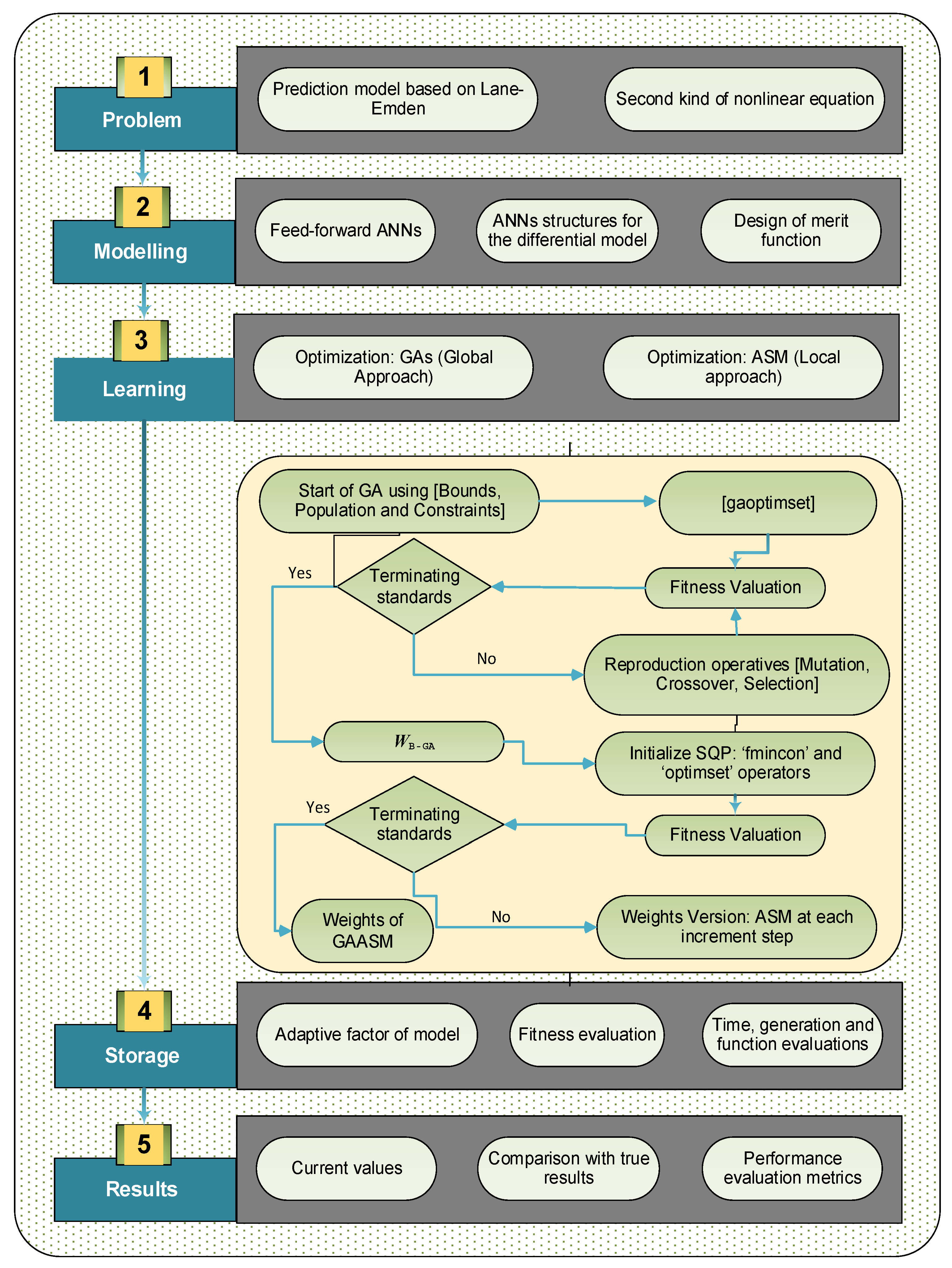
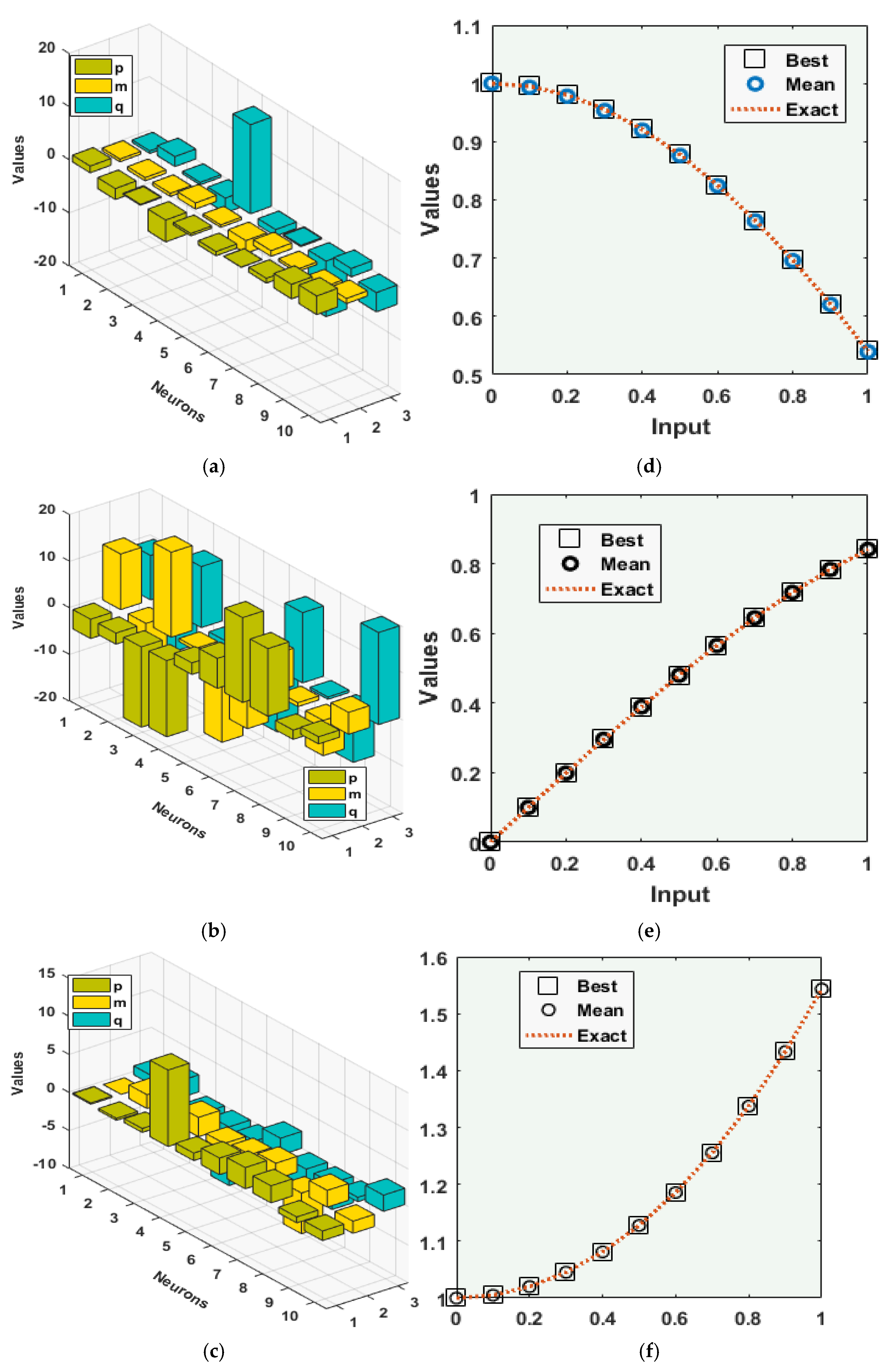
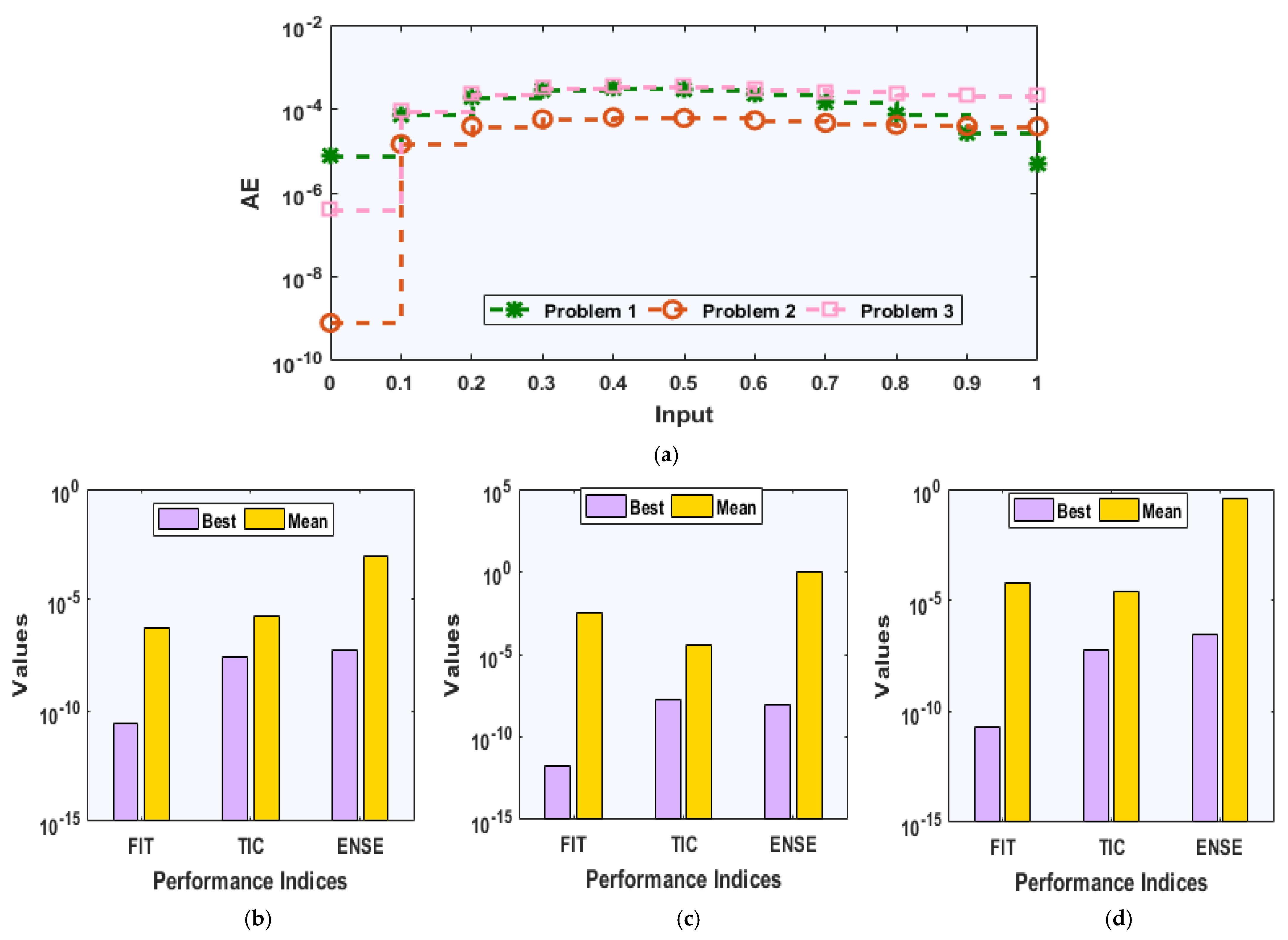

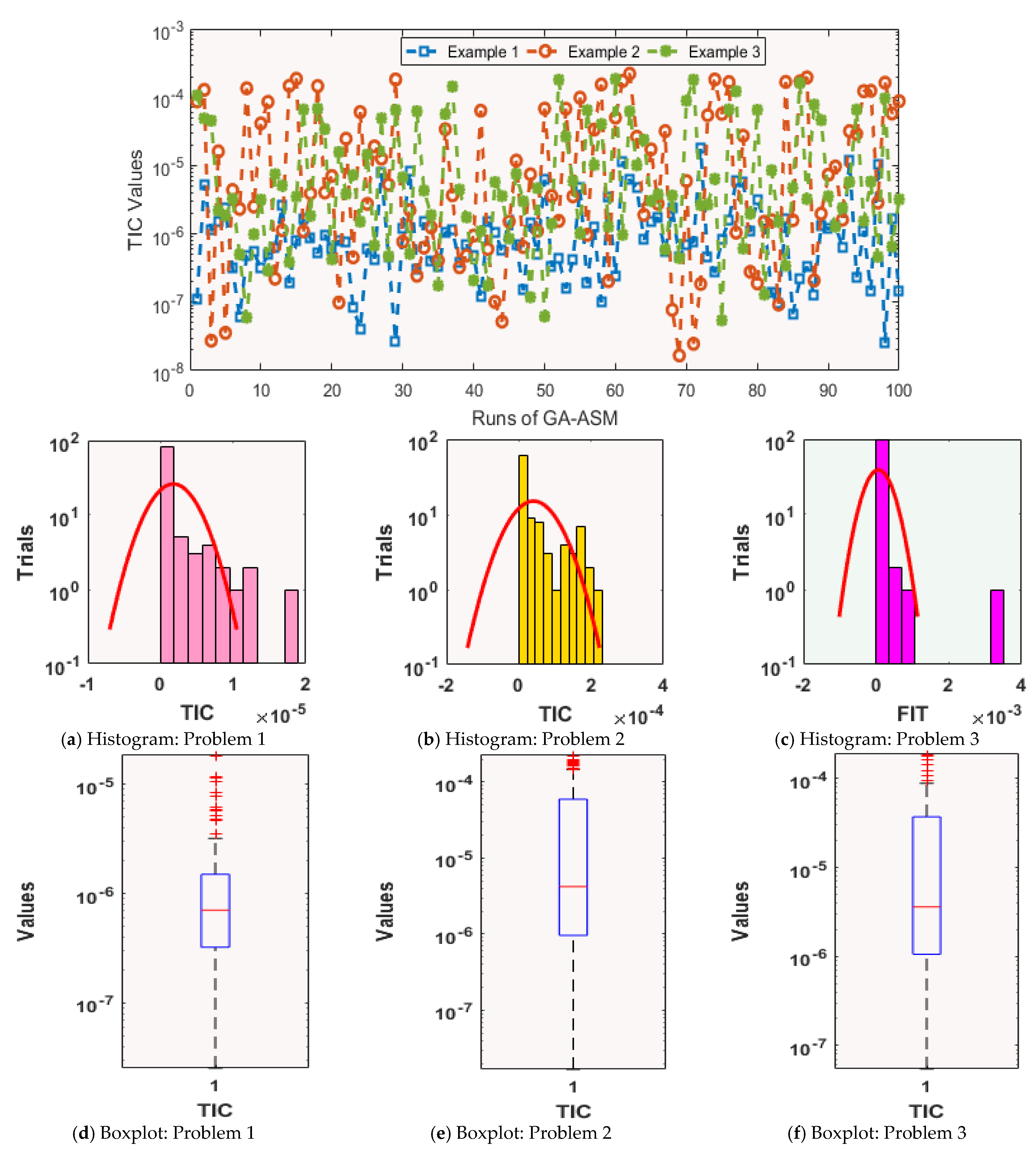
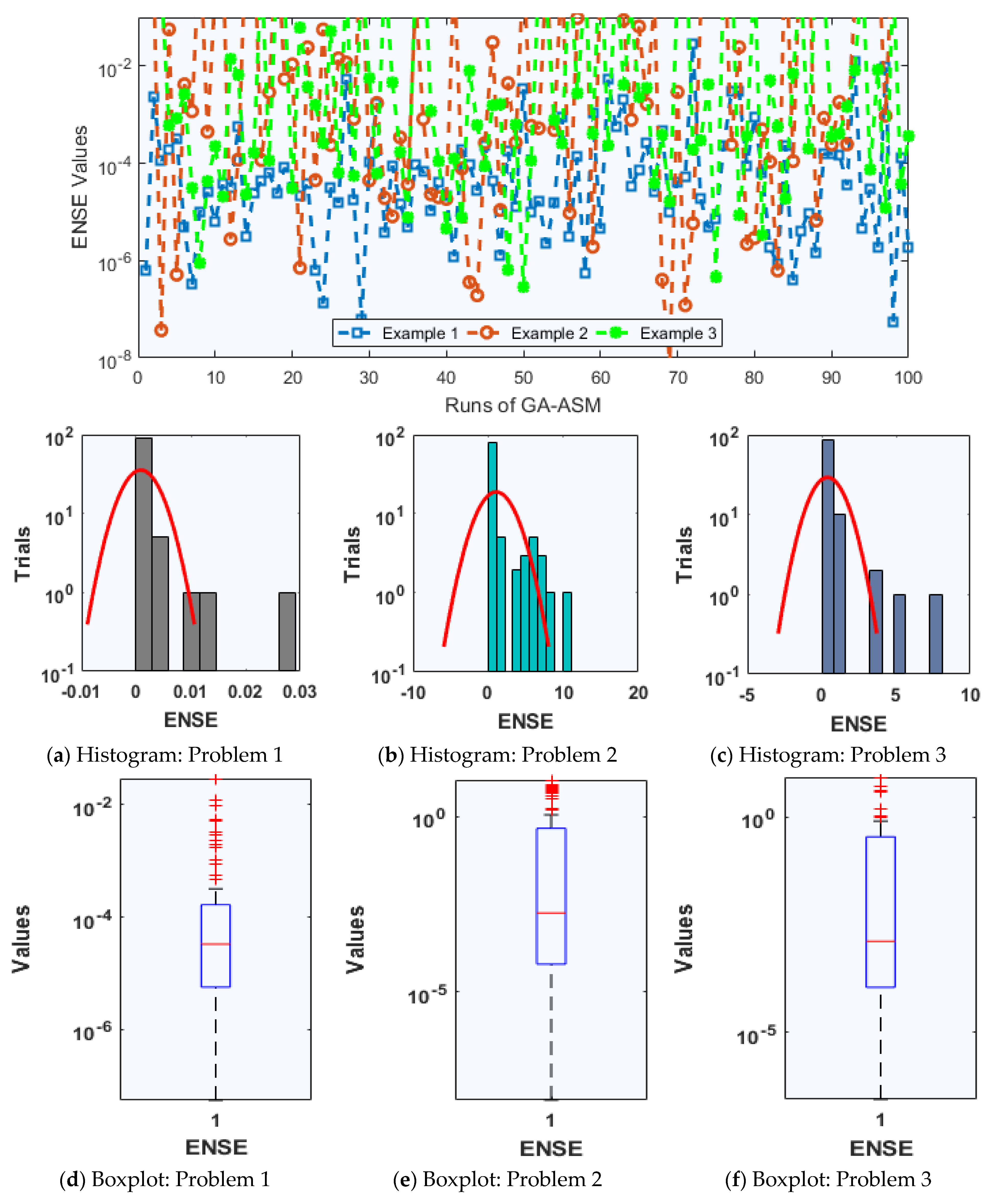
| Global GA procedure start |
| i-Inputs: The designated chromosome, together with the equal ordered entries of the system, as: W = [p, m, q] |
| ii-Population: The chromosomes are presented as: |
| p = [p1, p2, p3, …, pk], m = [m1, m2, m3, …, mk] and q = [q1, q2, q3, …, qk]. |
| iii-Output: The GA best values are labelled as |
| WB-GA |
| iv-Initialization: Design a weight vector “W” to make a chromosome. W is applied to generate P, i.e., an initial population. Fine-tune the GA values of generations. |
| v-Fitness scheming: Accomplish the EFit in Population for all W by using Equations (7)–(9) |
| vi-Termination: Terminate if any of the below conditions achieved. |
| EFit = 10−20, [Iterations = 85], StallLimit = 130, TolFun = 10−19, Population = 180, TolCon = 10−19, other values are defaulted |
| Move to storage |
| vii-Ranking: Rank each W in P for the EFit. |
| viii-Reproduction: Selection: [@selection uniform], |
| Mutations: @mutation adaptfeasible. |
| Crossover: @crossover heuristic, |
| Elitism: To obtain the best p values, continue the fitness assessment step. |
| ix- Storage: Store WB-GA, Generations, EFit, time and counts of function for existing trials of GA. |
| End of GA |
| ASM Started |
| i- Inputs: WB-GA is taken as start point. |
| ii-Output: The best GAASM weights are indicated as WGAASM. |
| iii- Initialize: Use WB-GA, bounded constraints, assignments, generations and other values. |
| iv-Terminate: Algorithm stops when any of these criteria are met. |
| EFit = 10−18, Iterations = 550, [TolCon = TolX = TolFun = 10−21] and [MaxFunEvals = 274,000] |
| While terminate |
| v-Calculation of fitness: Compute EFit, W, by using Equations (7)–(9) |
| vi- Adjustments: For the ASM, invoke “fmincon” routine. Calculate EFit of enhanced W by using Equations (7)–(9) |
| vii-Accumulate: Regulate WGAASM, time, EFit, generations and function counts. |
| ASM process End |
| Data Generations: The GAASM procedure repeats 100 times to find an extended data set of the optimization variables to solve the second kind of NLE-PDSM |
| Index | Mode | Proposed Solutions of Problems 1–3 Based on the Second Kind of NLE-PDSM | ||||||||||
|---|---|---|---|---|---|---|---|---|---|---|---|---|
| 0 | 0.10 | 0.20 | 0.30 | 0.40 | 0.50 | 0.60 | 0.70 | 0.80 | 0.90 | 1.0 | ||
| P-1 | Min | 3 × 10−9 | 3 × 10−6 | 8 × 10−5 | 9 × 10−5 | 4 × 10−5 | 3 × 10−6 | 1 × 10−4 | 1 × 10−4 | 6 × 10−5 | 2 × 10−5 | 4 × 10−6 |
| Med | 4 × 10−7 | 5 × 10−4 | 1 × 10−3 | 2 × 10−3 | 3 × 10−3 | 4 × 10−3 | 5 × 10−3 | 5 × 10−3 | 5 × 10−3 | 6 × 10−3 | 6 × 10−3 | |
| Mean | 4 × 10−6 | 4 × 10−3 | 7 × 10−3 | 9 × 10−3 | 1 × 10−2 | 1 × 10−2 | 1 × 10−2 | 1 × 10−2 | 1 × 10−2 | 1 × 10−2 | 1 × 10−2 | |
| SI-R | 1 × 10−6 | 7 × 10−4 | 2 × 10−3 | 3 × 10−3 | 4 × 10−4 | 4 × 10−3 | 4 × 10−3 | 5 × 10−3 | 5 × 10−3 | 5 × 10−3 | 5 × 10−3 | |
| STD | 4 × 10−7 | 1 × 10−2 | 1 × 10−2 | 1 × 10−4 | 1 × 10−2 | 2 × 10−2 | 2 × 10−2 | 2 × 10−2 | 2 × 10−2 | 2 × 10−2 | 2 × 10−2 | |
| P-2 | Min | 3 × 10−9 | 3 × 10−6 | 8 × 10−5 | 9 × 10−5 | 4 × 10−5 | 3 × 10−6 | 1 × 10−4 | 1 × 10−4 | 6 × 10−5 | 2 × 10−5 | 4 × 10−6 |
| Med | 4 × 10−7 | 5 × 10−4 | 1 × 10−3 | 2 × 10−3 | 3 × 10−3 | 4 × 10−3 | 5 × 10−3 | 5 × 10−3 | 5 × 10−3 | 6 × 10−3 | 6 × 10−3 | |
| Mean | 4 × 10−6 | 4 × 10−3 | 7 × 10−3 | 9 × 10−3 | 1 × 10−2 | 1 × 10−2 | 1 × 10−2 | 1 × 10−2 | 1 × 10−2 | 1 × 10−2 | 1 × 10−2 | |
| SI-R | 1 × 10−6 | 7 × 10−4 | 2 × 10−3 | 3 × 10−3 | 4 × 10−3 | 4 × 10−3 | 4 × 10−3 | 5 × 10−3 | 5 × 10−3 | 5 × 10−3 | 5 × 10−3 | |
| STD | 3 × 10−7 | 1 × 10−2 | 1 × 10−2 | 1 × 10−2 | 1 × 10−2 | 2 × 10−2 | 2 × 10−2 | 2 × 10−2 | 2 × 10−2 | 2 × 10−2 | 2 × 10−2 | |
| P-3 | Min | 3 × 10−9 | 3 × 10−6 | 8 × 10−5 | 9 × 10−5 | 4 × 10−5 | 3 × 10−6 | 1 × 10−4 | 1 × 10−4 | 6 × 10−5 | 2 × 10−5 | 4 × 10−6 |
| Med | 4 × 10−7 | 5 × 10−4 | 1 × 10−3 | 2 × 10−3 | 3 × 10−3 | 4 × 10−3 | 5 × 10−3 | 5 × 10−3 | 5 × 10−3 | 6 × 10−3 | 6 × 10−3 | |
| Mean | 4 × 10−6 | 4 × 10−3 | 7 × 10−3 | 9 × 10−3 | 1 × 10−2 | 1 × 10−2 | 1 × 10−2 | 1 × 10−2 | 1 × 10−2 | 1 × 10−2 | 1 × 10−2 | |
| SI-R | 1 × 10−6 | 7 × 10−4 | 2 × 10−3 | 3 × 10−3 | 4 × 10−3 | 4 × 10−3 | 4 × 10−3 | 5 × 10−3 | 5 × 10−3 | 5 × 10−3 | 5 × 10−3 | |
| STD | 2 × 10−6 | 1 × 10−2 | 1 × 10−2 | 1 × 10−2 | 1 × 10−2 | 2 × 10−2 | 2 × 10−2 | 2 × 10−2 | 2 × 10−2 | 2 × 10−2 | 2 × 10−2 | |
| Problem | G.FIT | G.TIC | G.ENSE | |||
|---|---|---|---|---|---|---|
| Min | Mean | Min | Mean | Min | Mean | |
| 1 | 2.4879 × 10−11 | 1.0885 × 10−8 | 5.4910 × 10−7 | 2.3769 × 10−4 | 2.5247 × 10−8 | 7.0495 × 10−7 |
| 2 | 1.6761 × 10−12 | 6.1081 × 10−9 | 1.4696 × 10−8 | 4.0544 × 10−3 | 1.6678 × 10−8 | 4.2113 × 10−6 |
| 3 | 1.9434 × 10−11 | 9.4892 × 10−8 | 4.4825 × 10−7 | 2.7903 × 10−3 | 5.4468 × 10−8 | 3.6132 × 10−6 |
Publisher’s Note: MDPI stays neutral with regard to jurisdictional claims in published maps and institutional affiliations. |
© 2022 by the authors. Licensee MDPI, Basel, Switzerland. This article is an open access article distributed under the terms and conditions of the Creative Commons Attribution (CC BY) license (https://creativecommons.org/licenses/by/4.0/).
Share and Cite
Sabir, Z.; Raja, M.A.Z.; Botmart, T.; Weera, W. A Neuro-Evolution Heuristic Using Active-Set Techniques to Solve a Novel Nonlinear Singular Prediction Differential Model. Fractal Fract. 2022, 6, 29. https://doi.org/10.3390/fractalfract6010029
Sabir Z, Raja MAZ, Botmart T, Weera W. A Neuro-Evolution Heuristic Using Active-Set Techniques to Solve a Novel Nonlinear Singular Prediction Differential Model. Fractal and Fractional. 2022; 6(1):29. https://doi.org/10.3390/fractalfract6010029
Chicago/Turabian StyleSabir, Zulqurnain, Muhammad Asif Zahoor Raja, Thongchai Botmart, and Wajaree Weera. 2022. "A Neuro-Evolution Heuristic Using Active-Set Techniques to Solve a Novel Nonlinear Singular Prediction Differential Model" Fractal and Fractional 6, no. 1: 29. https://doi.org/10.3390/fractalfract6010029
APA StyleSabir, Z., Raja, M. A. Z., Botmart, T., & Weera, W. (2022). A Neuro-Evolution Heuristic Using Active-Set Techniques to Solve a Novel Nonlinear Singular Prediction Differential Model. Fractal and Fractional, 6(1), 29. https://doi.org/10.3390/fractalfract6010029






